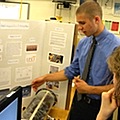- By Jeff Rubin
- Around Town
 Print
Print  First, find a problem, Ian Krywe tells his students.
First, find a problem, Ian Krywe tells his students.The Ithaca High School technology teacher requires the seniors in his year-long Engineering Design and Development (EDD) class not just to choose a project to complete during the class, a capstone course in which they apply the principles they've learned in four preceding engineering classes.
Only after they identify a real-world engineering challenge do the students decide on a project. Then, they must research the ways that other inventors have tried to solve the challenge, before designing, building, testing, and re-designing their own solution—all in just nine months.
The 17 students in this year's EDD class presented their six chosen problems—and proposed solutions—in an open-house poster session in mid-June highlighting their impressive work.
Five of the projects received a total of $1,854 in funding from the Ithaca Public Education Initiative (IPEI) in the form of Red and Gold Grants ranging from $150 to $500 (the maximum permitted). The sixth project did not apply for IPEI funding.
"Without the IPEI grants, five of the six groups wouldn't have been able to build their solutions," says Krywe. "IPEI’s grants supplement and support the things these students have learned in their three previous years."
At the open house, parents and other community members circulated past workbenches covered with computers, display boards and prototypes. Clipboards in hand, Krywe and the three other teachers in the department of technology and engineering education evaluated the students' projects and presentations.
Thanks to a friend on the Ithaca High swim team, Ned Przezdziecki, Katherine Schrader and Paul Stover decided to create an underwater lap counter that would utilize the timing touch pads the school already owns. Although the trio did not finish their project—few groups did—they say they learned valuable lessons along the way. Time management, Katherine and Paul agreed, is critical: you have to keep track of deadlines, apply early for funding and order project components well in advance. "Waiting on parts has been a challenge," Katherine said. "You can't get anything done if you don't have a part." Ned emphasized the need for redesign: "Think about what you can do if not everything works well."
Other IPEI-funded projects included:
- Engineering Exploration - Neill Morris-Knower and Phoebe Patwell created a personality-profiling website that uses an online quiz to help high school students interested in engineering find out which field of engineering best suits their personality.
- Hull Inspection Submarine - Avery Bodenstein and Daniel Schultz designed a remote-control submarine with an onboard live-feed video camera to inspect boat hulls for damage or fouling growth at depths of up to 15 feet.
- 3D Scanner - Simon Bohn, Michael Crossen, Christopher Evans and Andrew Walters designed a device that can make a three-dimensional computer model of an object. They also developed a two-week curriculum that will teach other students how to build and use their own 3D scanner.
- WildFire CNC Plasma Cutter - Istvan Burbank and James Eddlestone designed a computer-controlled device that will operate a plasma torch that uses ionized gas to cut metals quickly and accurately for use by the high school tech department. Eddlestone, a junior, plans to complete the plasma cutter next year.
- Ithaca High School ID Card System - Carson Case, Justin Newhouse and Emilio Petricola identified a system that could be modified to utilize the current student ID cards to allow students to sign in to class, pay for food in the cafeteria, and check in to privileged areas such as the library.
v9i24



